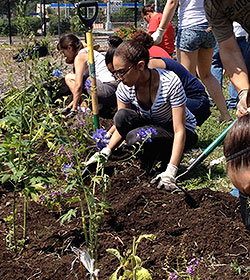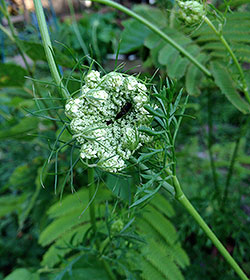An Urban Garden’s Mysticism
Posted in Learning Experiences on August 21 2014, by Diana Soler
Diana Soler is a NYC Summer Youth Employee with Bronx Green-Up, the community gardening outreach program of The New York Botanical Garden.
 Growing up in the city, I wasn’t one to appreciate wildlife. I ran away from it. Tall buildings and concrete provided me with comfort. Seeing empty lots of land confirmed this attitude for me. They looked like restricted mini-forests, having fences around the perimeter with weeds and trash caged inside. It was almost as if these spaces don’t exist, as the urban life surrounding them doesn’t acknowledge the presence of nature and all of the mystical treasures it has inside.
Growing up in the city, I wasn’t one to appreciate wildlife. I ran away from it. Tall buildings and concrete provided me with comfort. Seeing empty lots of land confirmed this attitude for me. They looked like restricted mini-forests, having fences around the perimeter with weeds and trash caged inside. It was almost as if these spaces don’t exist, as the urban life surrounding them doesn’t acknowledge the presence of nature and all of the mystical treasures it has inside.
Luckily, I was given the chance to see the light of these enchanted forests. While working for Bronx Green-Up (the community gardening outreach program of The New York Botanical Garden) as part of NYC’s Summer Youth Employment Program, I was exposed to community gardens that are being cared for and acknowledged by urban green thumbs. These once abandoned lots were turned into spaces where local community members can garden and establish meaningful relationships with both plants and people. The first task I am usually given when entering a new garden is to pull out weeds. I didn’t really know what I was doing at first. My common sense just told me to pull out the ones that look ugly, or that don’t quite fit in with the rest of the plants. Also, if there are decent-sized flowers on them, then those can stay.
Boy, was I wrong. During an office day, Community Horticulturist at Bronx Green-Up Sara Katz was planning a workshop about identifying different weeds found in Bronx gardens. She wanted me to make flashcards classifying different types of weeds for the workshop. This research project turned out to be a reality check for me. Weeds are awesome! Although there are some weeds that shouldn’t be kept in a garden for the sake of protecting other plants from their effects, there are a lot of benefits to having weeds. Some weeds, like the red clover (Trifolium pratense), are good to keep because they improve the soil. Red clover has nitrogen-fixing bacteria clinging to its roots, which helps the plant create a habitat that provides nitrogen for other plants. Others, like the hedge bindweed (Calystegia sepium), have beautiful flowers but are very dangerous to keep around other plants. As Bindweed grows, the vine tends to wrap itself around other plants which slowly kill them.

My favorites are the edible weeds. A lot of weeds, like the Wild Carrot, are used for medicinal purposes. Wild Carrot (Daucus carota), which has a cluster of white flowers and smells exactly like a carrot, was once used as a diuretic. Some are just tasty, like Chicory (Cichorium intybus) which has tall, bright blue flowers. The roots are sometimes added to coffee when ground or roasted. Some edible weeds can even be used to make tea for multiple purposes. Tea made from the Common Mallow (Malva neglecta) root, nicknamed “cheeses” because of the fruit’s shape, can be used for digestive problems and bronchitis. A wooly-leaved Common Mullein (Verbascum thapsus) tea can treat chest colds and reduce swelling.
For most people, the difference between a flower and a weed is a judgment. For some, weeds provide an alternate lifestyle in diet, health and wellness. As I walk home each day from work, I take a minute to soak in all the mysticism that lies in those enchanted forests a few blocks away.

